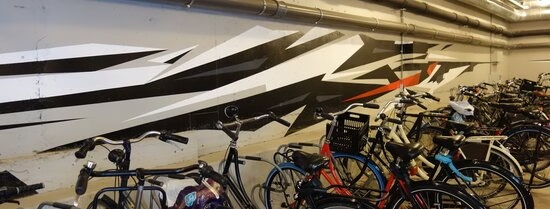Many students, staff and visitors to our university are consciously or unconsciously familiar with the art on campus Woudestein. Take Karel Appel's famous mosaic on the Tinbergen Building. But the art collection consists of more than 2,000 works. Luuk Bode's work revolves around that collection: from setting up an exhibition to removing an artwork due to works. He talks about what that involves and gives tips for discovering more art on campus: "If you keep your eyes open you will come across art everywhere here."
For over half a century, Erasmus University Rotterdam has had a collection in contemporary art that you can come across everywhere. In the outdoor space, but also in the offices. The collection was once started by Prof Piet Sanders. "Who had a good eye for art of the moment," explains Luuk Bode. "He visited studios and purchased works there. It ranged from totally unknown works to an early purchased work by Andy Warhol that is now worth a lot. Sanders established a certain line and it feels like our responsibility to continue this in a good way."
Very rich and extensive art collection
Art Affairs continues to purchase works. There are also regular exhibitions at the Erasmus Gallery and art loans for departments or buildings. But Bode also deals with minor repairs and sometimes gives tours of the campus. He proudly says: "I have been working here for seven years now but I still come across gems in the collection. Not every university has such a rich collection in terms of size and quality."
Art in the formative phase of your life
Luuk Bode is also an artist himself, having created the artwork in the bicycle basement underneath the K.P. van der Mandeleplein, for example. He finds that, as an artist, it is often not easy to get talking to the 'ordinary' viewer. So one of the most enjoyable things about working at the university is the conversations he has here. "Sometimes a whole conversation ensues about a work of art when I come to collect or bring something. After all, you bring art to people who might not seek it out themselves. Just the other day I had a whole conversation with security guards, which is very valuable."
According to Luuk, art at a university has great added value. "Art is seen by many young people in the formative phase of their lives. In that phase, it is extra important that art is offered. It enriches your life and can stimulate you spiritually."
"Work may well excite and doesn't always have to be easy, but it is meant to enrich and not be a source of annoyance."
Art triggers discussions
In addition, art can lead to discussion or is used as a 'conversation piece' during a meeting. "We also sometimes get reactions to works of art, for example those on the screens of the laptops people use," Bode says. "A work has been taken down sometime, as too many people have found it unpleasant. If you see that all the time when you flip open your screen at home, it's different than in the gallery. It matters a lot where you hang such a work and in what context. Work may well excite and doesn't always have to be easy, but it is meant to enrich and not be a source of annoyance."

Favourite works of art
Luuk Bode tips the reliefs in the C-hall as one of his favourite artworks. "These belong to the building and are almost unnoticeable, but if they were not there then something would really be missing." In the previous exhibition at the Erasmus Gallery, a François Morellet work from the collection hung there. "In the depot, it was a square work with a grid on it. But when I did research, it turned out that it had to hang at an angle so that the grid was straight," he says. "A very minimal work but hanging it at an angle really created something strange. One visitor also said he kept tending to hang it straight."
Take time to really look at art
Art is everywhere here on campus. In the stairwell of the University Library or on the steps by the pond, for example. "The gallery is just a nice place to walk through for ten minutes during your break. To clear your head or just fill it with ideas." A tip for when you're not sure how to look at art: "You don't have to immediately interpret everything, we learned as children to say something is a car or a tree, but you can also see something like that as something else. The colours and the structure. Stand quietly, look at it and notice what kind of feeling it evokes in you. In museums, I see people rushing through a room, but it's better to pick something out and take your time." He concludes, "And not all art is for everyone."
- More information
Want to find out more about Erasmus University Rotterdam's art collection? There is an art and culture route with over 50 artworks and take a look at the Erasmus Gallery.

